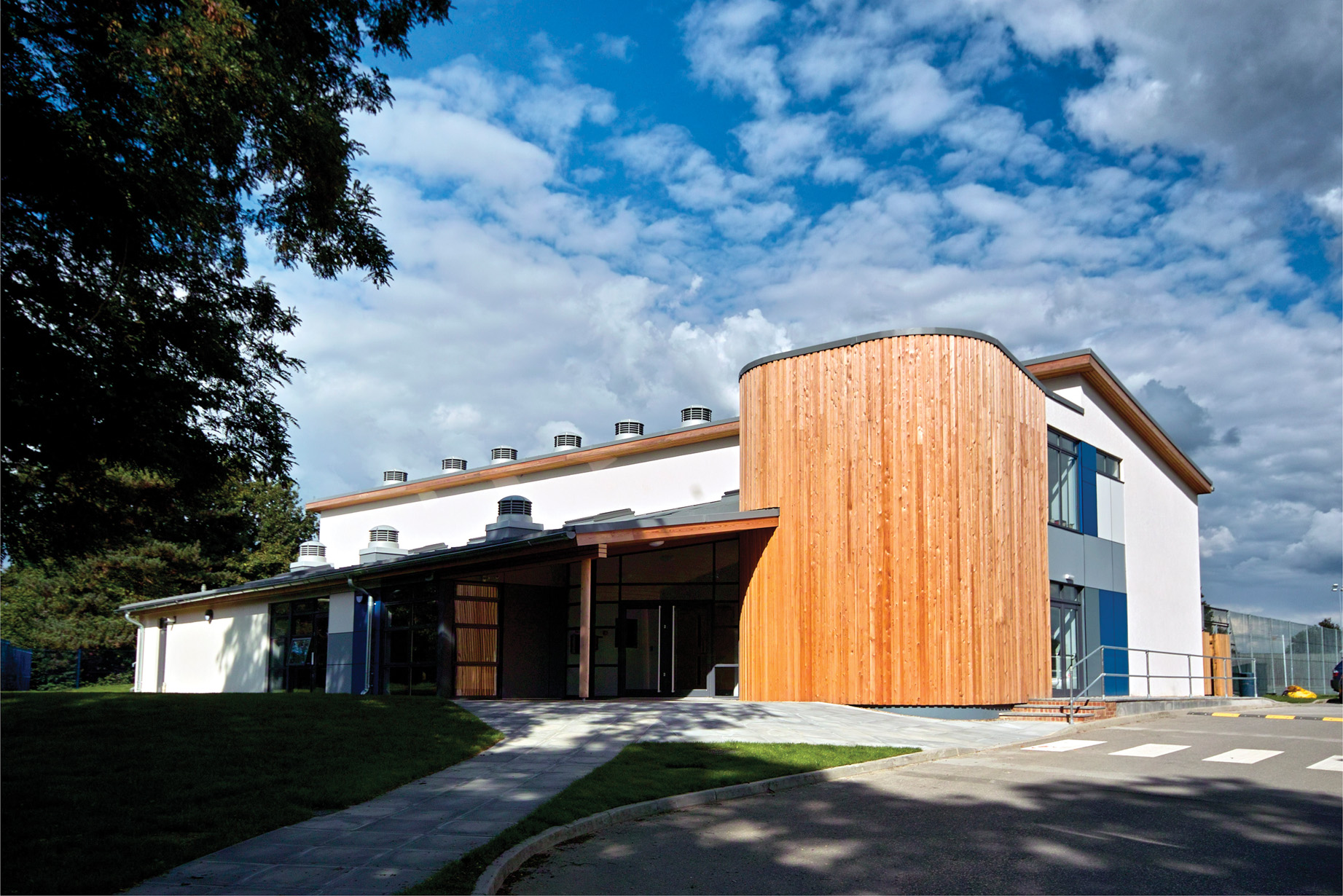
Credit: iStock/dolgachov
New guidelines on air quality in classrooms come into force later this year and are set to redefine ventilation in schools. Building Bulletin 101 (BB101) Guidelines on ventilation, thermal comfort and indoor air quality in schools has introduced a new category for ventilation – hybrid – in addition to the current mechanical and natural ventilation definitions.
‘Hybrid’ applies to systems that may be passive for the majority of the time, but that use fans if environmental conditions don’t allow classrooms to meet BB101’s temperature and carbon dioxide (CO2) requirements using unassisted ventilation.
BB101 changes at a glance
Mechanical systems – which use a fan to drive in airflow – must adhere to a daily average of 1,000ppm CO2. Natural ventilation systems cannot exceed a daily average of 1,500ppm CO2.
The degree of excursions has been restricted, too. CO2 levels can reach 2,000ppm for no more than 20 consecutive minutes in a given day.
The guide has also introduced the concept of adaptive thermal comfort, in line with CIBSE TM52 The Limits of Thermal Comfort: Avoiding Overheating in European Buildings – so the temperature threshold can change on a daily basis, depending on external conditions.
In criterion one, BB101 states that the number of hours the predicted operative temperature exceeds the maximum acceptable operative temperature by 1K or more must not exceed 40 occupied hours.
The new guidelines place tougher demands on ventilation strategies, and will have a significant impact on the design, specification and construction of schools in the future.
Air quality and thermal comfort are crucial for any building. On warm days, there are many benefits to natural ventilation – plenty of fresh air and a connection with nature. However, in cooler weather, some ventilation experts say a purely natural system can struggle to supply sufficient fresh air without causing unwelcome cold draughts. Others argue that draughts can be countered using heat recovery within natural systems.
Types of ventilation
BB101 outlines a range of ventilation strategies – from completely natural to totally mechanical. The type of strategy that can be used will be determined by the constraints of the classroom’s design.
Traditionally, natural ventilation – where the driving force for the supply of fresh air is wind and buoyancy – has been the standard solution for schools. It involves openable windows, or natural ventilation openings, and chimneys with manually operated dampers. But limited control options – for example, opening or closing windows – mean that, in more extreme weather or occupancy conditions, the space may be unsuitable for this type of ventilation. There are also limitations on the depth of room that can be naturally ventilated using passive means, and – depending on the external environment – there are potential challenges with noise and pollution ingress.
Mechanical ventilation gives a controlled supply and extract airflow, enabling a basic control of room temperature, humidity and air quality. The systems can be designed to allow local regulation – installing a responsive system using automatic or manual controls – and to deliver reasonable thermal comfort via heat exchangers.
A hybrid – or mixed-mode – system introduces outdoor air into a building by mechanical and passive means. These systems employ natural driving forces of the wind and the stack effect, and fans when natural forces alone do not result in the thermal requirements being met.
BB101 points out that there is a wealth of combinations on the spectrum between natural and mechanical ventilation.
The limits
According to the updated guide, mechanical systems – which use a fan to move air – must adhere to a daily average of 1,000ppm CO2, while their natural-ventilation counterparts cannot exceed 1,500ppm CO2.
The document has also restricted the degree of excursions – CO2 levels are allowed to reach 2,000ppm for no more than 20 consecutive minutes in a given day.
The reason for the difference in design maximum target levels for CO2 is that the variability of natural driving forces is much greater than that of a mechanical ventilation system, according to Annex A of BB101.
Whereas mechanical system fan speeds accelerate rapidly with rising CO2 levels to stay within the allowable range for indoor air quality (IAQ), natural ventilation is much more variable through the year because of the changing weather conditions.
“System choice should be based on thermal comfort, air quality and energy efficiency, as well as acoustics”
Colin Biggs, technical director at Nuaire, says the more onerous target for mechanical systems creates a bias towards natural ventilation. ‘The issue is that higher CO2 levels have a short-term effect on academic performance – for example, during a lesson – so the use of average levels is surely not an appropriate measure. But if these higher CO2 levels are deemed acceptable, why not apply them to mechanical systems as well?’
Biggs says that, in a mechanical system, if the CO2 levels were allowed to drift to 1,500ppm, the design fresh-flow rate could reduce from 8 L.s-1 per person to 5 L.s-1 per person. ‘This would translate into a fan-speed reduction and, therefore, an electrical-power reduction of around 70%. Noise levels would also reduce – by around 10dB – as would the capital cost of the system,’ he says.
Natural ventilation
Tom Lipinski, technical director at Ventive, says natural ventilation – unlike mechanical systems – has no running or maintenance costs. ‘They are not dependent on factors such as regular maintenance and electricity supply,’ he says. ‘If you combine that with heat recovery – so reducing heating costs in winter – you have the best of both worlds.’
Ventive’s system combines traditional stack ventilation on the roof with heat recovery, and façade openings to prevent overheating. It works when the heat exchanger inside the stack captures heat from the stale exhaust air, and uses it to warm up the supply air. Only 60-70% of the heat is extracted so enough buoyancy is left to keep air moving. Lipinski says the two air streams are kept separate, so the stale air does not contaminate the incoming air.
The drawback of natural ventilation systems is draughts in winter, but Lipinski says: ‘We don’t have that problem, because the incoming air is pre-warmed by the exhaust air.’
BB101 says the elimination of cold draughts in winter and in mid-season is a major design consideration for classroom ventilation systems, because the spaces have relatively low ceilings and high flow rates are required because of occupation density. Many naturally ventilated schools that could achieve the air-change rates in winter fail to do so because teaching staff do not open windows, to avoid draughts.
Lipinski says Ventive’s system is constrained in May and June, when wind and buoyancy are limited, and outside temperatures are equal to inside ones. But he says the system can be put into purge-ventilation mode by opening façade louvres.
However, Shaun Fitzgerald, CEO at Breathing Buildings, says a natural system would not have enough driving force on a warm windless day to aid airflow, unless the air has very large areas to travel through – which can make the system expensive. He says system choice should be based on thermal comfort – in both summer and winter – air quality and energy efficiency, as well as acoustics.

Although a school near a noisy road can be naturally ventilated, the amount of acoustic attenuation needed would make the cost of the system prohibitively high, Fitzgerald says. Road traffic also means air pollution, so façades facing onto busy roads will probably be ventilated using some form of mechanical system that offers filtration. Quieter façades can rely on passive means.
‘Different parts of schools might have different challenges, so there is not just one solution,’ says Fitzgerald. ‘Acoustics might be an issue on one side, architecturally landlocked rooms on another. Or there may be no roof access, so large ducts have to penetrate the building, meaning natural ventilation becomes inordinately expensive. The right answer might be a mixture of systems.’
A hybrid solution
Chris Iddon, design manager at SE Controls, says mechanical and hybrid systems provide enough air to meet IAQ requirements, but are often insufficient for cooling. Windows and louvres, on the other hand, can supply greater air flow to aid summer cooling but, during cold, inclement weather, the airflow can lead to occupant thermal discomfort.
Together with Charalampos Angelopoulos, a research student at Loughborough University, Iddon modelled a generic classroom using computational fluid dynamics (CFD) and analysed under what conditions it could be ventilated with windows without affecting occupant comfort.
In his paper, Evaluation of thermal comfort in naturally ventilated school classrooms using CFD, Angelopoulos found that if the external temperature was greater than 8°C – and wind speed was less than 10 m.s-1 – windows could be used to provide enough air to meet IAQ requirements and BB101 guidance on occupant comfort. Outside these parameters, some form of mechanical or hybrid solution would be required to temper the air.
Iddon says an ideal system would consist of a hybrid mixing box for background ventilation – ensuring CO2 levels are kept between 1,000 and 1,500ppm – and windows, to cope with mid-season IAQ and to prevent overheating in summer.
‘Windows also provide an important connection with nature, while ensuring occupants can manage their own environment,’ says Iddon. ‘People are less familiar with mechanical systems, which also have maintenance requirements – including filter changes – presenting a potential risk if they are not kept up to date.’
Iddon says natural ventilation using automated windows/vents is perfect for sports and assembly halls with high ceilings, as well as for transient spaces – such as communal corridors – where draughts are not an issue. Although air and noise pollution can present a challenge in some locations, he can envisage a future in which these are less of a problem. ‘By 2040, all new vehicles will be electric, so – if we are designing buildings to last 60 years – we should consider these future scenarios.’
It is useful to have alternative means of bringing air into a space, Iddon adds. ‘Roadworks outside, for example, can lead to occupants closing windows.’
Fitzgerald says a mixture of ventilation systems is nearly always used because school kitchens and toilets must have mechanical extract, as must architecturally landlocked rooms. ‘A mixture of systems can achieve better air quality and energy efficiency – one shouldn’t have to be traded off against the other,’ he adds.
Every school has to be dealt with on an individual basis; air quality, thermal comfort, noise and acoustics must be considered – and it must all be done within a tight budget.
Ventive case study
Six Ventive passive ventilation with heat recovery (PVHR) systems were installed at a Lewisham primary school, and monitored for one year.
According to Ventive, the CO2 levels in the monitored classrooms remained below 1,000ppm for 55.5% of occupied hours, below 1,500ppm for 85%, and below 2,000ppm for 97.5%.
The heat recovery efficiency of the system during the intense part of the study period averaged 94%.
Instances of windows being opened were also recorded, with ventilation rates increasing by an average of 138% when one window was opened, and by up to 280% with two windows open. The calculated volume flow rate increased to 145 L.s-1 and 330 L.s-1 respectively.
Vivian Dorizas, lead KTP associate at UCL – in partnership with Ventive – is evaluating the impacts of passive ventilation with heat recovery systems on the built environment and its occupants.

